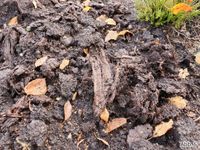A moor shaped by climate change?
The Great Moor is Germany’s most southerly area of fenlands. Precipitation here is less frequent and less regular than it is in the moors of the Emsland, for example. Throughout the history of our moor, there were recurring dry periods from which this approximately 6,500 year old tree trunk originates. Roots were frequently unearthed, making the removal of peat more difficult; but these were part and parcel of the characteristics and complications to peat cutting here.
Dendrochronological dating of around 500 pine trees from the Great Moor showed a timeframe from 4619 to 4431 BC (Fig. 2).
Peat moss emits hydrogen ions, creating an acidic environment that prevents competitors from growing. Peat moss can grow unbounded. The plant develops upwards. The rest dies off and becomes peat. The nitrogen that the plants need to grow is not drawn from the soil, but rather from rainwater. Figure 5 shows the evolution from inland waters via fenlands and raised bog to human cultivation.
The intact moor grows about 1 mm per year. Plant components (peat moss, cotton grass, rushes) often remain identifiable in the peat (Fig. 6).
The many roots and tree stumps, prevented the really large peat excavators, e.g. The “Giant of the Moor”, the largest electrically powered peat excavator in Europe, from being able to operate economically in our moor. Extraction work had to be interrupted too often.
Links to other stations in the museum - in English language:
<1> <2> <3> <4> <5> <6> <7> <8> <9> <10> <11> <12> <13> <14> <15> <16> <17> <18> <19> <20> <21> <22> <23>




